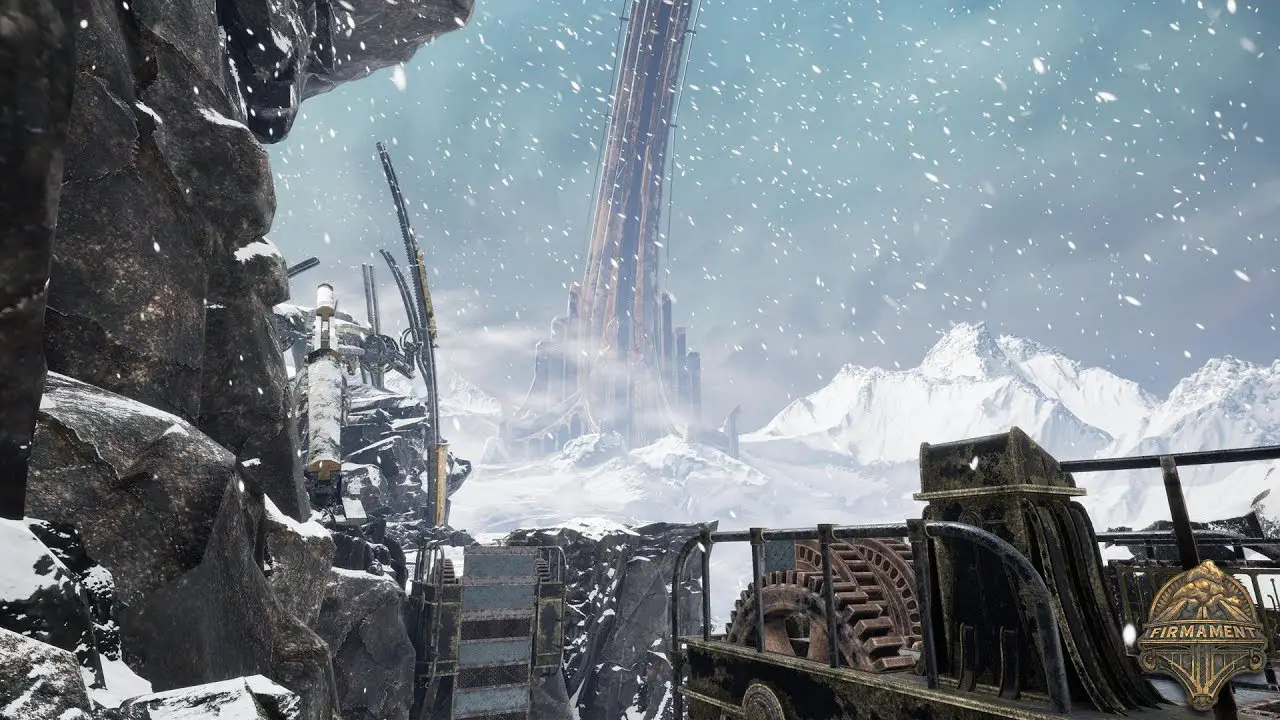Cyan, the company that brought the world genre-defining videogames like “Myst” and “Obduction,” announced the development of its new game “Firmament,” with the release of a Kickstarter at the end of March.
“Firmament” promises a return to the traditional Cyan strengths of puzzles and worldbuilding, with a few key additions. So what lies in store for players of “Firmament”?
What Will “Firmament” Look Like?
Cyan has provided little information about the storyline of “Firmament,” partly because the game is still in production, so the narrative and gameplay are still fluid. But the nature of Cyan games also contributes to this lack of certainty.
Like its predecessors, “Firmament” seems to be based on a mystery. The player is deposited in an unfamiliar world, where disaster and death have struck, and part of the narrative seems to be figuring out what happened. Divulging too much information upfront would ruin the fun.
Despite this, there are some clues about what to expect. “Firmament” appears to be another return to the adventure game base that made Cyan famous. The preview video created for their Kickstarter campaign showcases intricate puzzles and gorgeous worlds that look familiar to players of their earlier games. Its teaser trailer features a haunting narration that does little to define the plot of the game, but works wonders in establishing the overall atmospheric, steampunk aesthetic.
The images and videos of “Firmament” that Cyan has released show snow-covered peaks studded with machinery, moonlit corpses in everlasting repose and forests growing through forgotten infrastructure. The overall vibe is a post-apocalyptic world inhabited only by the the player and the dead. It’s a creepy look that lends itself well to mystery, puzzles and the Cyan aesthetic.
Although “Firmament” seems to fit the traditional Cyan style, it’s worth looking at what sets this game apart from the rest of Cyan’s repertoire.
Entering Virtual Reality
Something that plays at the heart of the game, and sets “Firmament” apart from the rest of Cyan’s collection is virtual reality. “Firmament” is being designed for VR systems like the Oculus and Vive. In fact, the initial teaser for “Firmament” specified that it was a “VR experience,” with no mention of 2D PC versions. Now, Cyan plans on including a PC version of the game that modifies VR functionality, but it’s clear that their intentions are to see their game played in the immersive VR world.
As a broke and constantly on-the-go graduate student, I don’t own a VR system; although, I can’t help but begrudge this decision, as the VR environment makes sense for a Cyan game. The production company has always made their unique worlds a staple of their games, and often rewarded players for exploring beyond the requirements of their puzzles. Allowing players to fully immerse themselves in these dynamic, expansive and alien locations is a logical choice.
This is not the first time Cyan has stepped their toes into the world of VR. They created a VR version of their last game “Obduction.” But the difference here is that Cyan’s experience comes from designing games for a traditional 2D setting and then porting them to the new format. “Firmament,” instead, will be created for VR first and therefore optimized around the demands of this format.
The VR setting allows Cyan to make use of a wide array of interaction tools that traditional keyboard-and-mouse interface can’t emulate. Primarily, this means the availability of gestural control. Actions within the game will be controlled by motions of the player’s hand, allowing them to wave, point, toggle and make use of any number of interesting movement options. Gestural control contributes to the immersive experience, allowing the player to further embody the main character by literally controlling their body. It also allows for what is known as “intuitive interaction” with the system.
Gesture control is a perfect choice for the traditional Cyan-type puzzles, too. Having crafted unique worlds and given them a history, much of the puzzles in games like “Myst” or “Obduction” require interacting with unfamiliar objects. Having an opportunity to manipulate such tactile puzzles in an intuitive, gestural way seems an ideal way to allow for progress in the game to be a truly embodied experience.
For the PC version of “Firmament,” the ability to access the necessary gesture library through a traditional mouse interface will be made available. This modification, although functional, seems as though it would inevitably pull the player out of the game. Cyan, however, is confident that the PC version will still be great, and that designing initially for VR will lead to a “better and more optimized PC version.”
While I’m excited for the VR nature of “Firmament,” it’s worth noting that this format does not go without controversy. While new VR systems are still being released, many members of the community are vocally wondering whether the whole enterprise is dead. Gesture controls enabled by VR systems have improved greatly over the years too, but problems still exist. Despite these issues, I’m excited to see Cyan tackle VR design and immerse myself in the worlds of “Firmament.”
No More Solo Travel
Another difference between “Firmament” and previous Cyan games is the inclusion of a sidekick character. Usually these games are about exploring worlds alone. Although the games require interaction with other characters in a populated world, it’s unusual in a Cyan adventure to be aided on the journey.
According to the Kickstarter page, “Firmament” provides the character with a “mechanical adjunct,” which appears to be a robotic helper that is necessary for solving puzzles and progressing through the worlds. While the adjunct is less human than a traditional companion, its human-esque actions and independence from the main character reduce the solitary effect that Cyan games are often known for.
While the isolation of a game like “Myst” contributed to its appeal, I’m curious and eager to see what gameplay with the adjunct is like in “Firmament”. Adding in a separate mechanical body allows for a new layer of complexity in puzzles, creating two-body problems of ordering and interaction that have otherwise been unavailable in Cyan games.
Kickstarter to the Rescue
“Firmament” is set for release July 2020, but is attempting to fund this release through crowd-sourcing. Since its announcement, the “Firmament” Kickstarter has received half of its funding, with less than two weeks to go to reach its funding goal of 1.285 million dollars.
If “Firmament” does not make this fundraising goal, the future of the game is unclear. Previous Kickstarters for Cyan games, including “Obduction” in 2013 and the 25th Anniversary Collection of “Myst” in 2018, easily met their funding goals, proving Cyan’s success in relying on Kickstarter funding. But in today’s age, it’s become increasingly difficult for gaming development companies to fund on platforms like Kickstarter.
As an avid fan of adventure games, puzzles and “Myst”‘s strange blend of steampunk and alien, I’m hopeful that “Firmament” will meet its Kickstarter goal and 2020 release projection. Not only do I want to play this game and solve its puzzles, I want “Firmament” to serve as an example for the possibilities of VR and gestural interfaces.
The gaming industry has found many ways to improve on immersive storytelling by inviting the player into the story and incorporating their choices into the narrative, but VR allows the player to make embodied actions in a way that 2D can’t. Fostering ideas that expand on our capabilities — as gamers, as designers and as storytellers — should be a priority.
















